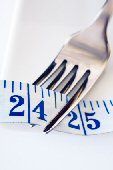Although I've only seen part of one episode of the TV show "The Biggest Loser", I've been curious about the Biggest Loser Diet I've been hearing about. I was sure it is low in calories, but how were the calories distributed? In particular, did contestants cut down their carb intake? To aid me in my research, I took the description of the Biggest Loser Diet in Prevention magazine, and created menus for three different days of the diet.
虽然我只看过电视节目“最大的输家”的片段,但是我一直对关于我听到的超级减肥王感到好奇。我确信它是低热量的,但热量如何分布?特别是,参赛选手要减少碳水化合物的摄入量吗?为了促进我的研究,在美国预防杂志上我对超级减肥王饮食进行了说明,创建了三天饮食不重样的菜单。
I tried to choose menus that I thought would be typical when following the guidelines, and deliberately avoided making choices that were the highest or lowest in carbs in each category. Here's what I found out about the Biggest Loser Diet:
在遵循指导方针的情况下,我试着选出了我认为比较典型的菜单,在每个分类中,刻意去避免选择碳水化合物高或低的食物。这就是我在超级减肥王饮食中的发现:

1) Calories: The diet has about 1100 calories per day
1)卡路里:该食谱中,每天饮食中摄取大概1100卡路里
2) Carbohydrate: The menus I chose were between 88 and 120 grams of carbohydrate per day, which was between 42% and 53% of the calories. The diet does not allow any added sugar, refined grains, or potatoes, so most people would be eating a diet that is somewhat lower in carbs, and much less glycemic than the way most people eat.
2)碳水化合物:我选的菜单里,碳水化合物每天摄取88至120克,等于摄取42-53%的热量。食谱中不允许添加糖、细粮或者土豆,所以大多数人吃的这顿饭,有含量很低低的碳水化合物、比大多数人摄取更少的血糖。
3) Protein: The diet is relatively high in protein. The menus I chose were between 100 and 120 grams of protein per day, which was between 35% and 46% of the calories.
3)蛋白质:饮食中蛋白质相对较高,我选的菜单是蛋白质每天摄取100-120克, 等于摄取35%-46%的热量。
4) Fat: The diet is very low in fat. The highest fat day was the one where salmon was included; that one had 20 grams of fat at 16% of calories. Other days were around 12% fat.
4)脂肪:饮食中脂肪含量很低,每天最高的脂肪摄取量是一只鲑鱼含有的脂肪量;一只鲑鱼含 20克脂肪和16%的热量,其他天大约是12%的脂肪。
译文属可可原创,仅供学习交流使用,未经许可请勿转载












